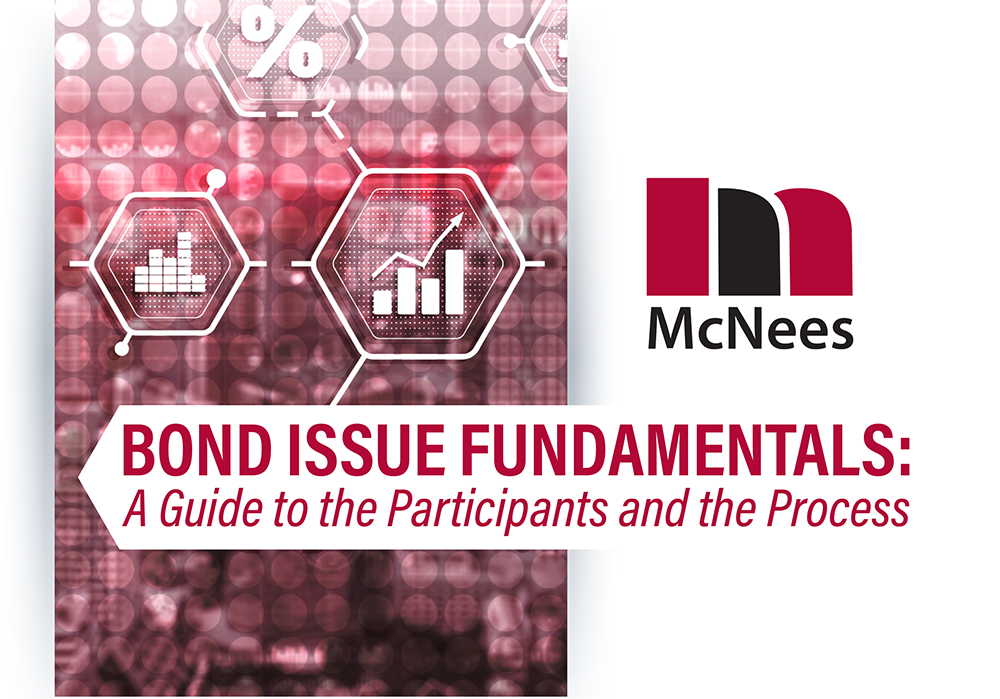Bond Issue Fundamentals: A Guide to the Participants and the Process
January 16, 2024
Publications
 A bond issue (a debt obligation of a local government) is often perceived as a mystery for many Pennsylvania local government officials and solicitors. The securities and tax regulations governing municipal bonds have grown increasingly complex in recent years further adding to the challenge of understanding the path toward a successful bond issuance. In this guide, McNees’ experienced bond counsel lawyers break down the fundamentals including the key players and steps involved to empower stakeholders to navigate this financial undertaking with confidence.
A bond issue (a debt obligation of a local government) is often perceived as a mystery for many Pennsylvania local government officials and solicitors. The securities and tax regulations governing municipal bonds have grown increasingly complex in recent years further adding to the challenge of understanding the path toward a successful bond issuance. In this guide, McNees’ experienced bond counsel lawyers break down the fundamentals including the key players and steps involved to empower stakeholders to navigate this financial undertaking with confidence.
PARTICIPANT ROLES AND RESPONSIBILITIES
Issuer. The most important participant in a bond issue is the municipal issuer of the bonds. The issuer undertakes the financing to fund capital projects or to refund existing debt. All other participants assist the issuer in raising the money.
Solicitor. The issuer’s day-to-day lawyer is referred to as the solicitor. The solicitor represents the issuer in the financing and delivers a legal opinion at the closing which may include:
- That the issuer is validly existing
- That the issuer’s officers validly hold their offices
- That the public meeting at which the bond issue is approved was properly called and held
- That there is no material litigation pending against the issuer that would adversely impact the bond issue
In many cases, the solicitor is not an expert in public finance but is usually an experienced lawyer who understands the issuer’s operations better than any of the other professionals involved in the bond issue. Therefore, the solicitor plays a crucial role in protecting the interests of the issuer by asking questions. If the solicitor and the issuer are not comfortable with anything related to the bond issue, the solicitor should slow down the process.
It is particularly important that the solicitor reviews the description of the issuer in the disclosure document for the bonds (commonly called the official statement, or OS) and that the solicitor ensures the issuer’s readiness for its post-issuance compliance responsibilities (described below).
Bond counsel. It is customary for the issuer to retain a law firm with public finance experience to work with the solicitor on the legal aspects of the bond issue. This lawyer or law firm is commonly referred to as bond counsel. The issuer should ensure that bond counsel identifies the issuer as its client in its engagement letter.
Bond counsel cooperates with the issuer and the financial advisor or underwriter in structuring the transaction, with particular emphasis on legal matters related to state law approvals and compliance with federal tax and securities laws. Bond counsel delivers an opinion at the closing. Bond purchasers rely on the bond counsel’s opinion when the bonds are purchased because the opinion confirms:
- The issuer has properly authorized and issued the bonds
- The bonds are enforceable under the law
- Interest on the bonds is exempt from federal income tax and certain state taxes (to the extent applicable)
Financial advisor and/or underwriter. Two financial functions take place in a bond issue: First, the issuer may hire a financial firm to advise it on the structure of the bond issue. Second, the issuer may hire a financial firm to buy the bonds with the intent to sell them to purchasers. In recent decades, the Securities and Exchange Commission (SEC) has changed and expanded the rules governing what types of firms can perform these two functions.
Traditionally, the issuer could hire an underwriter (also called an investment banker) to perform both functions in a negotiated offering — the underwriter would provide structuring advice and then market the bonds to purchasers. Or the issuer could hire a financial advisor solely to advise on structuring the bond issue. (The financial advisor would not sell the bonds.) In this scenario, the issuer would sell the bonds with the advice of the financial advisor either through a competitive sale in which multiple underwriters bid or through a negotiated offering where a selected underwriter buys the bonds and resells them to purchasers.
Financial advisors were seen as having a fiduciary duty to the issuer, but financial advisors were largely unregulated. Underwriters did not have a fiduciary duty to the issuer (just an obligation to deal fairly), but underwriters were heavily regulated.
In response to the financial crisis of 2008, Congress enacted the Dodd-Frank Wall Street Reform and Consumer Protection Act. Dodd-Frank created a new category of “municipal advisors” and gave the SEC and the Municipal Securities Rulemaking Board (the MSRB) with jurisdiction over financial advisors and other participants in municipal bond transactions.
The bottom line is that the days of unregistered financial advisors are over — these advisors are now registered as “municipal advisors” and have a fiduciary duty to the issuer and issuers must acknowledge that their underwriters do not owe a fiduciary duty to the issuers.
Paying agent or trustee. Once the bond issue has closed, the issuer makes debt service payments to the bondholders through a paying agent or trustee, which is a commercial bank chosen by the issuer. Depending on the structure of the bond issue, the paying agent or trustee may also hold certain moneys of the issuer in a reserve fund or other funds. If the bond issue ever defaults, the paying agent or trustee often represents the bondholders in remedial proceedings against the issuer.
Security for bonds. The two most common types of security for municipal bonds are represented by general obligation bonds and revenue bonds:
- For a general obligation bond, the issuer pledges its full faith, credit and taxing power to secure the bonds and it agrees to budget, appropriate and pay the debt service due on the bonds each year.
- In a default situation, the bondholders can petition a court to force the issuer to raise real estate taxes in an amount sufficient to pay the debt service.
For a revenue bond, the issuer pledges the revenues of a particular project, such as a sewer system, to secure the bonds and it agrees to set rates at a level sufficient to pay the debt service.
It is possible to combine both concepts in a bond issue. For example, a municipal authority may issue revenue bonds secured by the revenues of its sewer system, and a municipality may also secure the authority’s bonds with a municipal guaranty which operates essentially as a general obligation. These are called guaranteed revenue bonds.
Credit enhancers. It sometimes makes economic sense for the issuer to utilize a third party to guarantee the bond issue — this is called credit enhancement. For instance, one of the following may occur:
- A municipality may agree to guarantee the bonds of a municipal authority
- An insurance company may issue an insurance policy guaranteeing payment of debt service on the bonds
- A bank may issue a letter of credit guaranteeing payment of debt service on the bond
- A bank may enter into a standby bond purchase agreement under which the bank will pay the purchase price of bonds that bondholders may tender
Regardless of the form of credit enhancement used, the goal is the same – to improve the marketability of the bond and secure a better interest rate for the issuer.
PROCESS OF A BOND ISSUE
Selection of participants and structuring the transaction. The first step is for the issuer to select bond counsel and the financial advisor or underwriter. This selection should be undertaken almost immediately after the issuer has identified a project to be financed by a bond issue.
The issuer and the solicitor work with these participants to structure the financing and answer the following key questions:
- What is the purpose of the issue — to fund a capital project, to refund prior debt or a combination of both?
- What are the legal parameters involved — does the capital project serve a proper legal purpose and can the debt be refunded under the federal tax rules?
- How should the bonds be sold — through negotiation with one underwriter or through a bidding procedure with multiple underwriters?
- Does credit enhancement make economic sense? (That is, is the cost of the insurance or letter of credit less than the resulting debt service savings to the issuer?)
- Will a derivative, such as an interest rate swap, be utilized?
- What are the benefits and risks of each structure?
Once the structure is formulated, the issuer needs to select the paying agent or trustee and the credit enhancer, if any, and then all participants begin to prepare the required documentation:
- The underwriter or financial advisor and the issuer prepare the disclosure document, which is usually called the preliminary official statement
- Bond counsel drafts the ordinance, resolution or indenture and other legal documents
- The underwriter or financial advisor and the issuer prepare the initial disclosure document which is usually called the preliminary official statement
Marketing the bonds and the bond sale. When the preliminary official statement is in proper form, it is distributed by the underwriter to potential purchasers. The marketing period usually lasts about one week.
At the end of the marketing period, the issuer holds a public meeting at which time the bond sale is held:
- If the issuer has chosen a negotiated offering with one underwriter, then the underwriter comes to the public meeting with a firm purchase proposal
- If the issuer has chosen an offering with bids from multiple underwriters, then the financial advisor collects the bids on the day of the public meeting, usually utilizing an internet bidding process
The issuer then accepts the purchase proposal at the public meeting by adopting the ordinance or resolution prepared by bond counsel. The purchase proposal contains the specific terms of the bond issue: principal amount of the bonds, interest rates, amortization schedule and prepayment provisions.
It also sets forth the conditions of closing. Once the deal is “cut” at the bond sale, a final official statement is prepared and sent by the underwriter to the purchasers and the participants proceed toward the closing.
DCED approval and the closing. If the issuer is a municipality or school district, bond counsel will prepare a package to be filed with the Pennsylvania Department of Community and Economic Development (DCED) in accordance with the requirements of the Local Government Unit Debt Act (LGUDA). DCED has 20 days to approve the bond issue. Other issuers of debt in Pennsylvania may have different statutory approval requirements.
Usually, the closing occurs about one month after the bond sale. Before that closing date, bond counsel distributes drafts of various agreements, certificates and legal opinions for review. At the closing, the participants execute the various closing documents. The underwriter wires the purchase price for the bonds to the paying agent or trustee. At the direction of the issuer, the paying agent or trustee pays the costs of issuance and applies the balance to fund a construction or project fund or to refund the prior debt. After the closing, bond counsel distributes a complete set of the closing documents to each participant.
Post-issuance compliance. After a bond issue closes, there are requirements under the tax code and securities laws that continue to apply to the bonds. On the tax side, there are regulations governing the investment and spending of bond proceeds and the use of bond-financed facilities. On the securities law side, there are requirements to make annual financial disclosures and special event disclosures with the MSRB.
Both the Internal Revenue Service (IRS) and the SEC strongly encourage issuers to adopt and follow written post-issuance compliance policies, and regulators are becoming increasingly aggressive in supervising these requirements. Before the bond issue closes, the issuer and solicitor should work closely with bond counsel and the financial advisor or underwriter to help the issuer develop these post-issuance compliance policies. After the closing, the issuer and its solicitor should ensure the issuer takes these policies seriously and follows them. It is often a good idea for the issuer to retain a third-party “dissemination agent” to assist in monitoring and filing required post-issuance continuing disclosure.
ADDITIONAL CONSIDERATIONS
Now that we have reviewed the participants and the steps, here are a few additional points to consider:
- If the issuer intends to cover the initial costs of a capital project with non-bond proceeds and later reimburses itself for those expenditures with bond proceeds, the issuer should consult with its solicitor or bond counsel about having its governing body adopt a “reimbursement resolution” that sets forth their intention to reimburse such costs. Failure to adequately address this issue at the time the expenditures are made could prevent the issuer from being able to reimburse these costs from tax-exempt bond proceeds later.
- Sometimes, the issuer is acting as a “conduit” issuer. In such a case, the issuer issues the bonds and loans the proceeds to a third-party borrower, which is often a nonprofit corporation such as a hospital or university.
- The borrower is responsible for paying the debt service on the bonds. Both the issuer and the borrower need to be concerned with the procedural, tax, prevailing wage and securities law aspects of the bond issue.
- Although the financial advisor or underwriter usually prepares the draft of the preliminary official statement and the final official statement, it is really the issuer’s disclosure document. The issuer and its solicitor should carefully review the contents of the documents to ensure that the official statement contain no misstatement of a material fact and no material fact about the issuer is omitted from the official statement.
- If the issuer plans to issue bank-qualified bonds at some point during the year, this consideration should be communicated to bond counsel during the structuring process.
- If the bonds are being issued to finance a capital project, the issuer should focus well before the closing on the investment strategy for the bond proceeds.
- Sometimes, an issuer may want to adopt an ordinance or resolution, as applicable, which approves parameters and delegates approval of the final pricing of the bonds to a specific municipal official or to the borrower. In such a case, the bond sale occurs after the governing body takes its official action.
- If the issuer plans to enter into an interest rate swap agreement in connection with a bond issue, the issuer should retain an experienced financial advisor to advise it on the swap and the issuer should make sure it understands the risks involved in the transaction.
McNees’ Public Finance and Government Services team is available to provide comprehensive legal advice and answer questions on navigating Pennsylvania’s bond market. Our attorneys regularly serve as bond counsel for a wide range of clients including Pennsylvania counties, cities, boroughs, townships, school districts and authorities as well as for-profit and nonprofit organizations including healthcare and higher education institutions. We also represent borrowers, underwriters, banks, trust companies and other financial institutions in financings. McNees is listed in the “Municipal Bond Attorneys” section of the most recent edition of The Bond Buyer’s Municipal Marketplace.
© 2024 McNees Wallace & Nurick LLC
This Article is presented with the understanding that the publisher does not render specific legal, accounting or other professional service to the reader. Due to the rapidly changing nature of the law, information contained in this publication may become outdated. Anyone using this material must always research original sources of authority and update this information to ensure accuracy and applicability to specific legal matters. In no event will the authors, the reviewers or the publisher be liable for any damage, whether direct, indirect or consequential, claimed to result from the use of this material.







